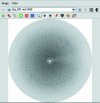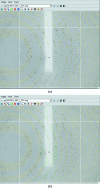iMOSFLM: a new graphical interface for diffraction-image processing with MOSFLM
- PMID: 21460445
- PMCID: PMC3069742
- DOI: 10.1107/S0907444910048675
iMOSFLM: a new graphical interface for diffraction-image processing with MOSFLM
Abstract
iMOSFLM is a graphical user interface to the diffraction data-integration program MOSFLM. It is designed to simplify data processing by dividing the process into a series of steps, which are normally carried out sequentially. Each step has its own display pane, allowing control over parameters that influence that step and providing graphical feedback to the user. Suitable values for integration parameters are set automatically, but additional menus provide a detailed level of control for experienced users. The image display and the interfaces to the different tasks (indexing, strategy calculation, cell refinement, integration and history) are described. The most important parameters for each step and the best way of assessing success or failure are discussed.
Figures







References
-
- Arndt, U. W. & Wonacott, A. J. (1977). Editors. The Rotation Method in Crystallography Amsterdam: North-Holland.
-
- Briggs, P. & Cowtan, K. (2007). CCP4 Newsl. 47, contribution 7.
-
- Campbell, J. W. (1995). J. Appl. Cryst. 28, 236–242.
-
- Evans, P. (2006). Acta Cryst. D62, 72–82. - PubMed
Publication types
MeSH terms
Grants and funding
LinkOut - more resources
Full Text Sources
Other Literature Sources

